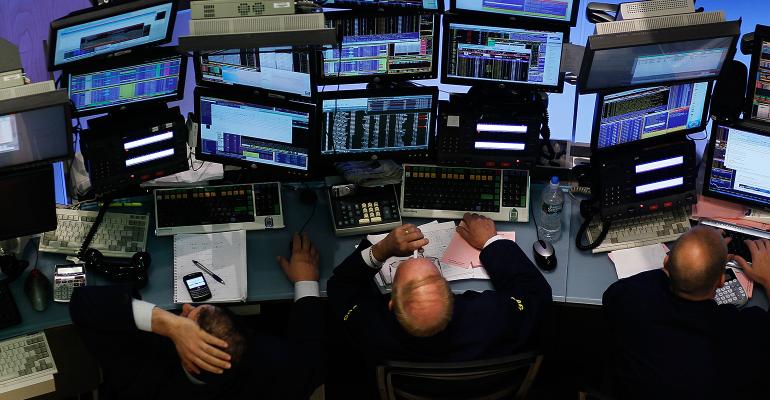By Ksenia Galouchko
(Bloomberg) --Big-name funds are issuing words of caution that the safest trade on Wall Street, betting on low-volatility stocks to protect against market turmoil, is looking increasingly precarious.
Legal & General Investment Management Ltd. and Barclays Investment Solutions are among those warning that billions of dollars flowing into the defensive strategy has made it overcrowded and expensive.
Even as shares with muted swings performed exactly as advertised last quarter -- shedding less than half of the S&P 500 Index’s 14 percent decline -- fears are growing the trade won’t prove a port in the next storm.
“Low volatility might be becoming vulnerable as investors chasing recent performance and buying into gloomy 2018 outlooks flock into it,” said John Roe, head of multi-asset funds at Legal & General with a combined 985 billion pounds ($1.3 trillion) under management. “It is becoming a relatively consensus position, which for us is a warning sign.”
Amundi, Robeco and HSBC Private Bank are among major asset managers that have been recommending the investing style to clients still on tenterhooks over the outcome of U.S.-China trade talks, the path of interest rates and flagging global growth.
Based on quant research suggesting that investors chase volatile names and undervalue stocks that swing less, low-volatility equities can provide a cushion when markets tank, but on the flipside will typically lag rallies.
That makes their appeal during last quarter’s $5 trillion equity meltdown obvious and hints at their attractiveness to money managers playing defense.
‘Unanswered Questions’
“2019 still has a lot of uncertainties, many questions are still unanswered, and in this environment low volatility can still outperform because it’s such a unique situation,” said Bruno Taillardat, global head of smart beta and factor investing at Amundi.
Investors poured $2.5 billion into U.S.-listed ETFs tracking low volatility in January, the most of any factor category. The iShares Edge MSCI Min Vol USA ETF alone added $1 billion, capping nine months of non-stop inflows, as markets fretted a slew of developments in trade, U.S. politics and global growth signposts.
But the deluge of cash may be jeopardizing a central premise of the strategy -- that tranquil stocks are undervalued. The price-to-earnings multiple of the S&P 500 Low Volatility Index sits near its highest since at least 2013, even if it has come down from its 2017 peak.
“It’s hard to argue that you are getting a particularly inexpensive entry point, which may dent your longer term returns from the factor,” said Will Hobbs, chief investment officer at Barclays Investment Solutions in London.
Even Sanford C. Bernstein Ltd., which recommends the shares for investors convinced January’s rally was a dead-cat bounce, concedes the “valuation case is less clear in the U.S. than it is globally or in Europe.”
Rate Risk
Another vulnerability is rising interest rates, thanks to low-volatility shares’ elevated exposure to bond proxies like utilities and high-dividend payers. While the Fed might have put to rest fears of an imminent rate hike for now, there’s little consensus around the view that borrowing costs will remain depressed for much longer.
“As real safe-haven yields move higher, you tend to find that the relative appeal of other income strategies can wane a bit,” said Barclays’ Hobbs.
Seeking out low-volatility stocks with high-quality balance sheets is important “because many low-vol names are exposed to high leverage, like utilities and telecoms,” which can make them sensitive to higher rates, said Roland Kaloyan, the head of European equity strategy at Societe Generale SA.
Perhaps the most important message is that investors shouldn’t rely on low-volatility strategies to the exclusion of everything else, according to Willem Sels, the chief market strategist at HSBC Private Bank. He recommends focusing on quality, while also holding some U.S. growth and low-volatility shares.
“There’s a lack of visibility and high uncertainty in the market, people lack conviction,” said Sels. “You need to be balanced in this environment. You can’t be a single-factor investor.’’
To contact the reporter on this story: Ksenia Galouchko in London at [email protected] To contact the editors responsible for this story: Blaise Robinson at [email protected] Yakob Peterseil, Sid Verma





